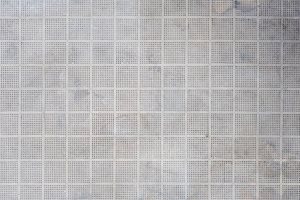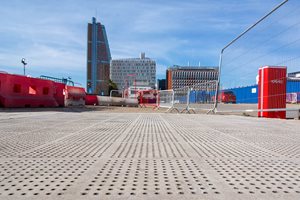Kiacrete
A new kind of permeable paving embeds recycled plastic tubes in a self-compacting cementitious material

It is well known that both precast and in-situ permeable pavement products can reduce stormwater run-off by allowing rainfall to drain through hard urban surfaces. This makes towns and cities less prone to flooding, helps with groundwater recharge, and can reduce the need for conventional storm drainage. Unsurprisingly they have become more popular in recent years – but urban floods, driven by expanding cities and climate change, persist. So why are such systems not used even more widely?
Inspired by a desire to help prevent destructive urban flooding, Dr Alalea Kia gained her PhD at Imperial College London, researching permeable concrete pavements. She set out to design a new type of infrastructure that could be used in a wider variety of applications, and require minimal maintenance. Typical permeable concrete uses a no-fines mix to achieve an open structure. Her system, dubbed Kiacrete, comprises a self-compacting cementitious material poured in situ around a permanent formwork of vertical plastic tubes. A trial at Imperial’s own White City premises was installed in summer 2020 and, to Kia’s delight, is still performing well.
 “The lightweight permanent formwork, made from recycled plastic, interlocks like Lego to cover the required area,” she says. “We then pour the self-compacting material to the required depth, and once it has set, the surface is lightly ground to open up the pores, creating a direct route for rainwater to flow to the sub-base.” Using a denser concrete with holes gives Kiacrete a higher strength of 50-60MPa, expanding the range of locations where permeable paving can be used. The size of the tubes, 6mm in diameter, has also enabled it to perform well in challenging conditions: “Even though the trial is near a dusty building site, the system still works very well after two years in service with no maintenance.”
“The lightweight permanent formwork, made from recycled plastic, interlocks like Lego to cover the required area,” she says. “We then pour the self-compacting material to the required depth, and once it has set, the surface is lightly ground to open up the pores, creating a direct route for rainwater to flow to the sub-base.” Using a denser concrete with holes gives Kiacrete a higher strength of 50-60MPa, expanding the range of locations where permeable paving can be used. The size of the tubes, 6mm in diameter, has also enabled it to perform well in challenging conditions: “Even though the trial is near a dusty building site, the system still works very well after two years in service with no maintenance.”
Kia’s spin-out company, Permia, is speaking to local government, transport infrastructure operators, engineering consultancies and contractors about installing Kiacrete in different kinds of field site. “The first trial was relatively light use – pedestrians and occasional site vehicles. But Kiacrete is easily adaptable and we want to test it under more challenging conditions.” She is also keen for the technology to be adopted internationally – for example, in monsoon climates.
 The diameter and spacing of the tubes, as well as the cementitious material, can be adjusted to suit different applications, she adds, and not only to vary the drainage capacity: “By spacing tubes further apart, for example, we could introduce coarser aggregates into the mix to make it stronger, or add skid-resistance. We can also use rebar between the tubes to make it stronger still – something that cannot be done with open-structure permeable concrete as the water ingress would cause it to corrode.”
The diameter and spacing of the tubes, as well as the cementitious material, can be adjusted to suit different applications, she adds, and not only to vary the drainage capacity: “By spacing tubes further apart, for example, we could introduce coarser aggregates into the mix to make it stronger, or add skid-resistance. We can also use rebar between the tubes to make it stronger still – something that cannot be done with open-structure permeable concrete as the water ingress would cause it to corrode.”
In 2021, Kia won a Royal Academy of Engineering research fellowship to apply her technology to airports, by engineering a new system capable of keeping them clear of surface water, ice and snow all year round. She has also been awarded a £2m grant by UK Research and Innovation to develop the first permeable pavement with sufficient strength and resilience for infrastructure such as highways and railways. “I want to conduct state-ofthe- art research that will benefit the environment and society,” she says, “particularly places affected by extreme weather events such as urban flooding and drought.”
Interview by Tony Whitehead
Published in CQ Summer 2022